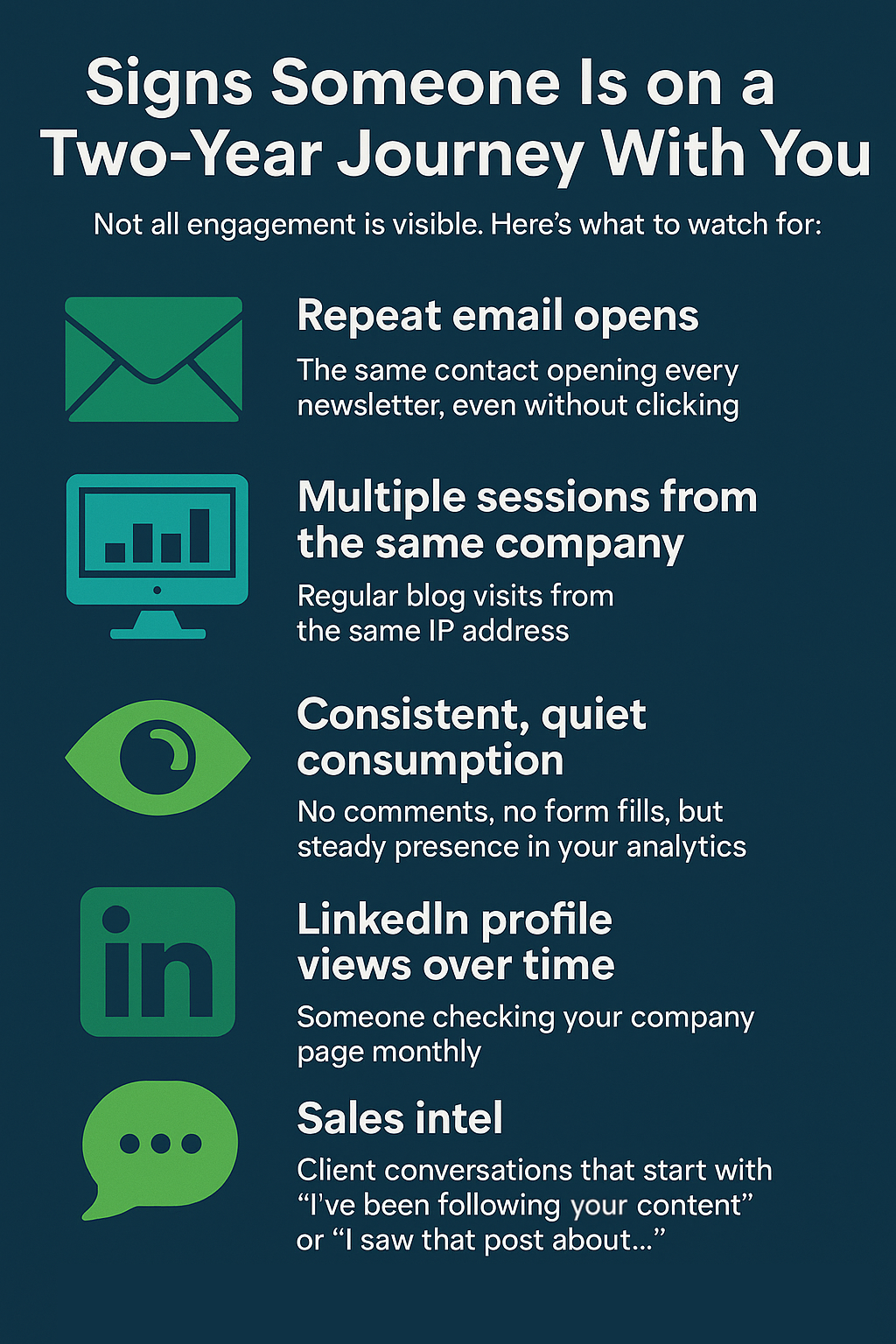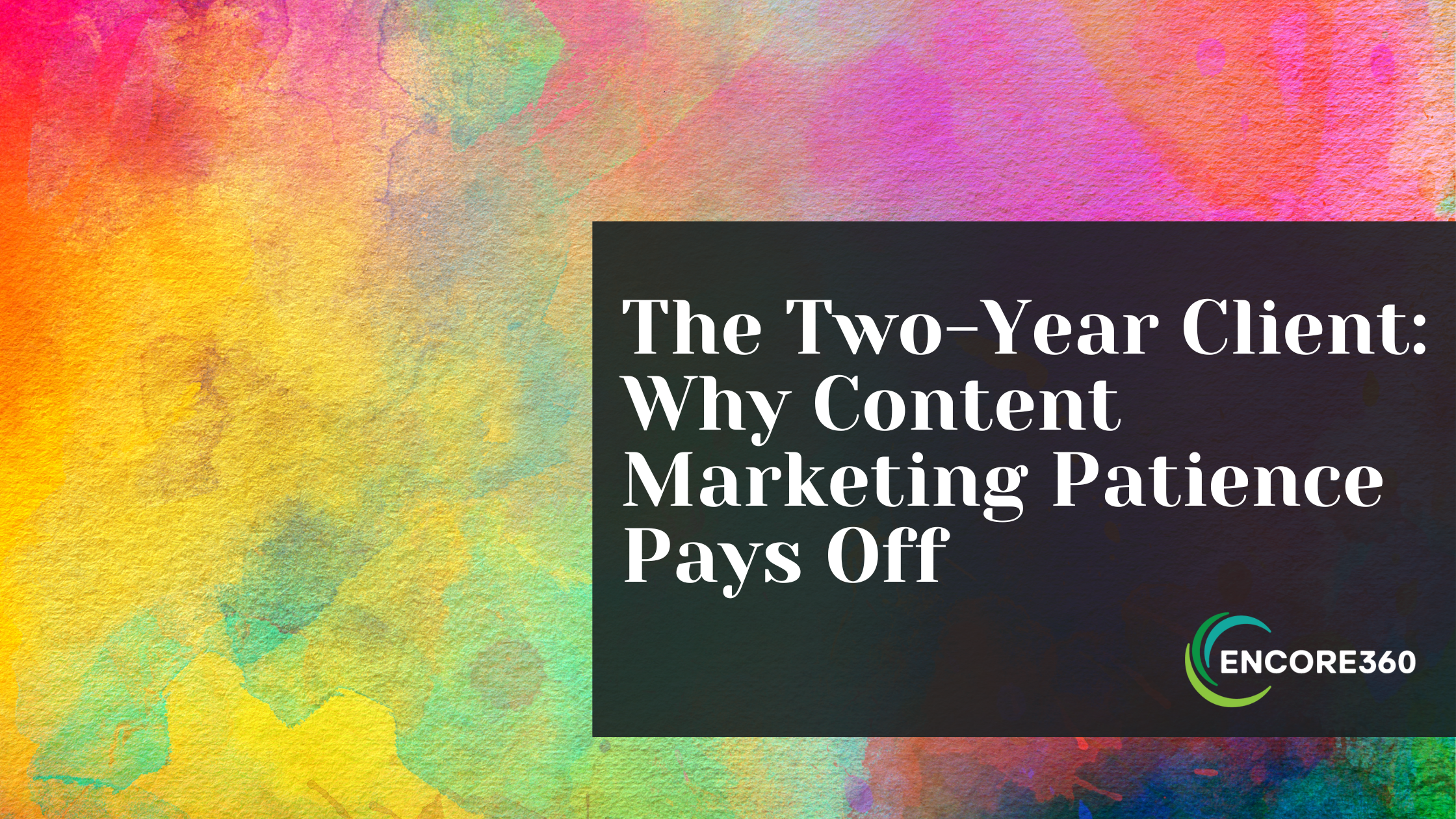Here’s a pattern we’ve noticed: A client we’ve been working with for other services mentions they’re finally ready to invest in content marketing. When we ask what changed, they say something like, “We’ve been reading your stuff for two years. We’ve seen how you think about content. When we got budget approval, you were the obvious choice.”
They weren’t buying content services when we first started working together. But while we collaborated on other projects, they were consuming our content. The educational content we published consistently — with no blatant sales angle — built trust that eventually led to a sale.
“We’ve worked on accounts for a couple of years now that are just coming to fruition,” said Jim Gilbride, CEO of Encore360. “They followed our content for two years. They’ve been educated along the way. We’ve helped them make adjustments in their business without ever trying to sell them something. And now, when they’re about to execute a content strategy, who are they going to hire? The company that’s already helped them.”
This is how modern B2B buying works. And it’s also why most content strategies fail: companies quit months before the payoff.
The Silent Journey: What Two Years of Content Looks Like
While these clients were working with us on other services, something powerful was happening beneath the surface. They were opening every newsletter, reading blog posts that helped them think differently about their marketing, and watching our team’s perspective evolve.
Jim describes the dynamic: “Helping your customer base helps retain clients. It continually educates companies already doing business with you. And it helps you retain those clients longer. As opposed to once I’ve promoted something to you… It brings you no value anymore.”
Educational content works differently from promotional content. It creates value whether someone buys or not. And that value compounds over time.
When these two-year clients finally reach out about content services, the sales cycle is usually short. There’s no need to prove expertise — they’d been watching us demonstrate it for 24 months. The decision was already made.

Why Most Companies Quit Too Early
Most content strategies die at the six-month mark.
Marketing teams are measured quarterly. When a blog post doesn’t generate immediate pipeline, it feels like a failure. When six months pass without obvious ROI, the strategy gets shelved.
But B2B buyers don’t move on marketing timelines. They move on business timelines: budget cycles, organizational readiness, internal consensus-building. These processes take time. Often years.
Campaign thinking says: start, sprint, stop, measure, move on.
Media thinking says: show up, serve, repeat, compound.
The cost of quitting at month six isn’t just lost momentum. It’s the upsell opportunity that was six months away from materializing.
How to Stay Consistent If You Can’t See the ROI
The biggest challenge is maintaining belief in the strategy when the dashboard isn’t showing proof of return.
Track the Right Signals
Stop obsessing over form fills and start watching for:
- Repeat visitors from the same companies
- Growing direct traffic
- Increased brand search volume
- The same email contacts opening every newsletter
- Sales reps hearing “I’ve been reading your blog” on calls
Build for 24 Months, Not 6
Months 1-6: Choose core formats you can sustain. Establish a rhythm: monthly is better than weekly burnout. Focus on being genuinely helpful, not promotional.
Months 7-12: Double down on what’s working. Start recognizing the same names engaging with your content.
Months 13-18: Your company name starts appearing in conversations. Sales calls begin with “I read your piece about…”
Months 19-24: Content you published eighteen months ago still drives traffic. Sales cycles shorten because trust is pre-built. The two-year upsell happens.
Make It Sustainable
Jim’s advice is simple: “Just start. Pick one platform, whether it’s LinkedIn, whether it’s email… Go mine that content and just start. And you don’t have to publish every day. Try to do a piece a month and be consistent.”
Consistency is crucial. Pick a cadence you can maintain for years, not weeks. Batch your content production. Ruthlessly repurpose it. Celebrate the small wins: a thoughtful comment, content forwarded internally, a sales rep who references your blog unprompted.
The Metric That Really Matters
When someone in your target market has a problem, do they think of you?
Are you showing up in conversations where you’re not physically present? Are clients quoting your ideas in meetings? Are customers forwarding your content to colleagues?
Authority is the compound interest of content. It builds slowly, through patterns of showing up with something useful. Then, suddenly, you’re the obvious choice for the next service.
The Advantage of Staying When Others Quit
Most of your competitors will abandon their content strategy at month six. That’s your advantage.
While they’re starting from zero again, you’re building momentum. While they’re chasing the next campaign idea, you’re becoming the trusted voice.
As Jim notes, companies are “huge knowledge bases” sitting on “years and years of content.” The challenge isn’t having something to say, it’s extracting it and sharing it consistently.
“Every company has good content to produce, but a lot of companies have a hard time extracting it from their business,” Jim explains. “The knowledge base, how deep it goes within each company, is years and years of content.”
The client who expands services in year two offers tremendous value. They arrive educated, convinced, and ready. It’s a partnership built on demonstrated expertise.
Start Building Two-Year Interest
Buyers make decisions based on the accumulated impression of competence, helpfulness, and consistency they’ve observed over months or years.
Your job isn’t to close fast. Your job is to stay present. To keep publishing. To remain a helpful voice when everyone else is sales-pitching.
The best time to start building that two-year relationship was two years ago. The second-best time is today.
Your future client (or your next upsell opportunity) is already watching. Will you still be in front of them when they’re ready?
